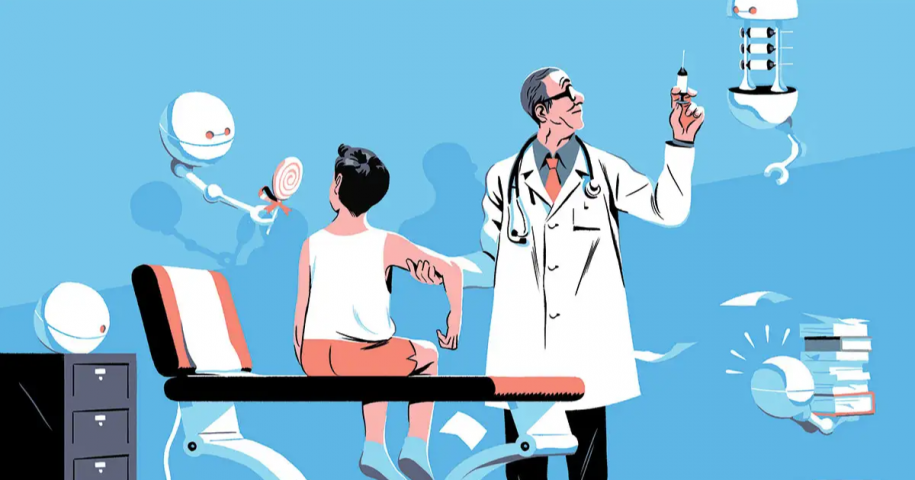Artificial intelligence is reshaping healthcare delivery. But how are physicians using AI in a daily clinical context?
In a recent article, we explored seven applications of AI across the industry. We’ve also written about other AI topics, such as an introduction to generative AI for doctors, the accuracy of AI-generated clinical notes, patient perspectives on AI, the best AI medical scribes, and whether AI can reduce physician burnout.
Today, we’ll explore how AI can help physicians streamline their daily work. Specifically, we’ll discuss how AI can:
- Automate Clinical Documentation
- Support Clinical Decision-Making
- Triage Patient Communication
- Diagnose Medical Images
- Automate Routine Tasks
Each topic includes a Software Spotlight, highlighting practical tools that illustrate AI’s impact in real-world settings.
How Physicians Use AI to Streamline Work
Automate Clinical Documentation
Physicians spend ten hours weekly on charting, clinical notes, coding, and other administrative tasks. However, generative AI is changing this dynamic by powering tools that can automate most of the documentation process.
For example, AI medical scribes can transcribe conversations between doctors and patients in real time, generate complete drafts of clinical notes, and update electronic health records with minimal physician input. Tools like this can save physicians hours weekly, allowing them to spend less time in the EHR and more time with patients.
Software Spotlight: Mobius MD’s Conveyor AI
Conveyor AI is a premium AI-powered medical scribe solution designed to seamlessly capture and document patient encounters. Mobius MD built Conveyor AI for healthcare providers who use an iPhone and want to reduce administrative work, streamline documentation, and focus more on patient care.
Support Clinical Decision-Making
AI can also assist physicians in making better-informed clinical decisions by evidence-based recommendations at the point of care. AI-driven clinical decision support (CDS) tools draw on vast datasets–including a patient’s medical history, current health data, and recent medical research–to provide treatment suggestions tailored to each patient.
For example, a physician treating a patient with multiple chronic conditions might use a CDS tool to quickly evaluate the potential benefits and risks of different treatments. AI can suggest options that align with the latest research and are personalized to the patient’s health profile. Tailoring treatment this way reduces errors and improves outcomes. Rather than replacing the clinician’s expertise, AI tools like this offer supportive “second opinions,” enhancing clinical confidence and decision accuracy.
Software Spotlight: UpToDate
UpToDate is a trusted clinical decision support tool that provides physicians with evidence-based, real-time answers to clinical questions. The platform is popular among healthcare providers who need quick, reliable access to the latest medical research and recommendations at the point of care.
Triage Patient Communication
Chatbots are very good at answering routine questions, triaging symptoms, and helping patients schedule appointments based on urgency. One example, Buoy, can also guide patients to appropriate care settings based on their reported symptoms.
Using AI to direct patients to the right resources leads to fewer unnecessary appointments and a more efficient workflow for doctors. By offloading routine inquiries and triaging more straightforward cases, virtual assistants free up physicians’ time for more complex cases and urgent needs. These tools also give patients faster responses and ensure they seek the proper care at the right time.
Software Spotlight: Buoy Health
Buoy Health offers an AI-driven virtual assistant that checks patients’ symptoms, provides triage guidance, and facilitates easy access to care. Buoy is designed for healthcare systems looking to improve patient engagement and streamline the triage process.
Diagnose Medical Images
AI-powered imaging tools already assist radiologists and other specialists in accurately identifying abnormalities in X-rays, MRIs, and CT scans. Deep learning models trained on large datasets of medical images can detect early-stage cancers, fractures, and other conditions, often identifying subtle details that the human eyes alone might miss.
This technology doesn’t replace radiologists. Instead, it provides a powerful “second read” to improve diagnostic accuracy and reduce the likelihood of missed findings. Hospitals are increasingly using AI-enhanced imaging tools, with many reporting faster imaging workflows and improved diagnostic confidence among their teams. These tools will likely play a growing role in helping physicians across specialties interpret imaging and make quicker, more accurate diagnoses.
Software Spotlight: Nanox Vision
Nanox Vision is a leading AI imaging platform that analyzes medical images to detect various conditions accurately. It’s designed for radiologists and healthcare organizations that want to enhance diagnostic accuracy and improve patient outcomes.
Automate Routine Tasks
Beyond documentation and imaging, AI is helping physicians automate many routine tasks that, while necessary, often pull them away from patient care. For example, AI-powered systems can assist with appointment scheduling, follow-up reminders, and prescription refills.
When a patient needs a routine medication refill, AI can automatically verify eligibility and send the refill request to the appropriate pharmacy. Similarly, AI systems can send patients reminders for upcoming appointments or lab tests, helping them stay on top of their care without adding additional workload for the provider.
Software Spotlight: UiPath
UiPath is a leading automation platform that uses robotic process automation (RPA) to streamline routine administrative tasks in healthcare. Designed for healthcare providers and systems, UiPath automates appointment scheduling, claims processing, and data entry.
Reducing Burnout and Focusing on Patient Care
By offloading time-intensive and repetitive tasks, AI has the potential to reduce physician burnout. Doctors say burnout is linked to time spent on documentation and administrative work. When thoughtfully applied, AI allows clinicians to dedicate more time to what drew them to medicine in the first place: engaging directly with patients and providing attentive care.
